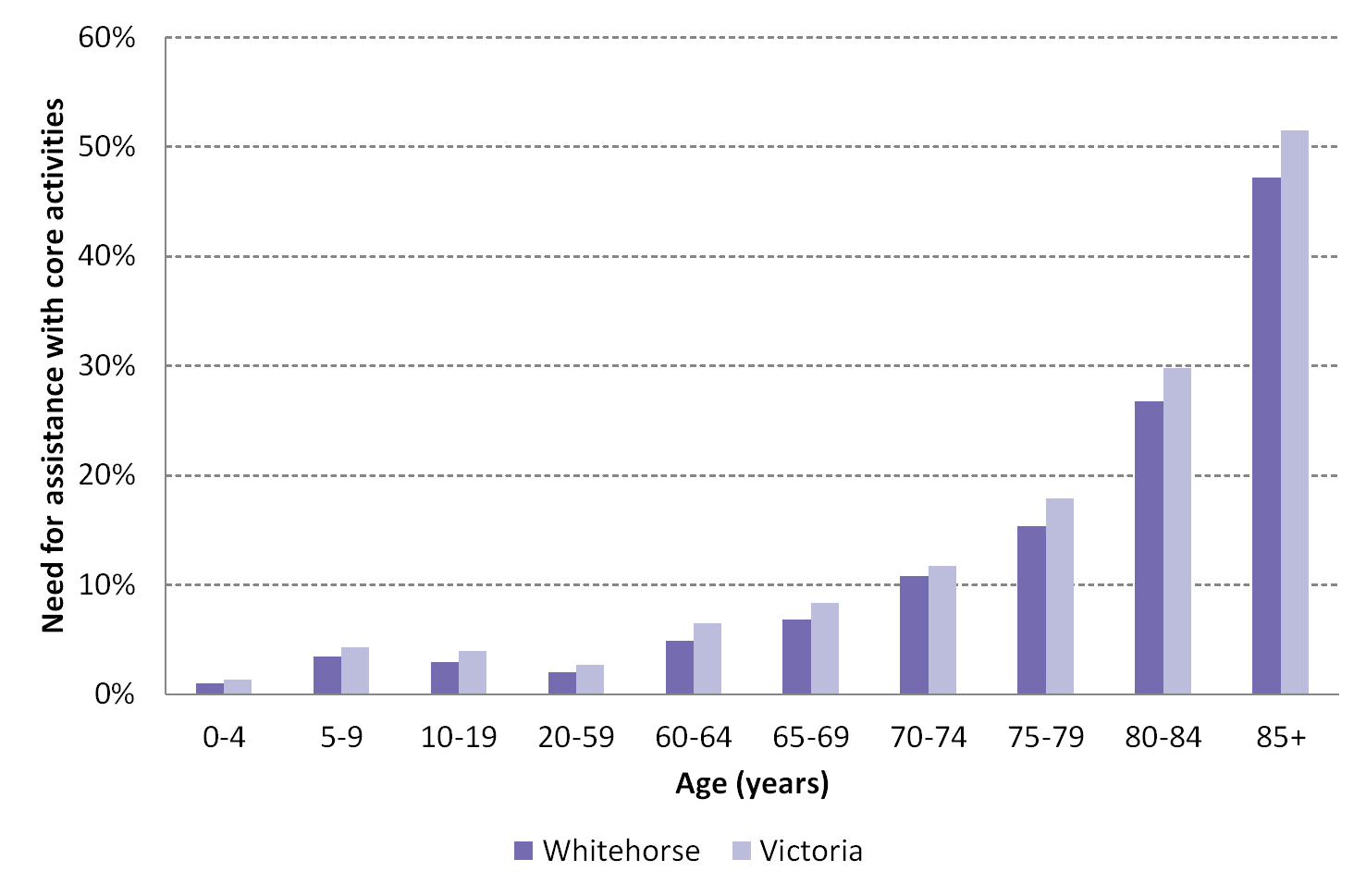This factsheet provides demographic information about people with a disability in the City of Whitehorse. Although primarily based on 2022 Survey of Disability Ageing and Carers, different statistical sources were used to compile this factsheet. The definition of disability changes between statistical sources which makes direct comparison difficult.
Prevalence of Disability
The 2022 Survey of Disability, Ageing and Carers (ABS, 2024) [SDAC] found that 5.5 million people in Australia (21.4 per cent) reported having a disability. This data is not broken down into local government areas, however when applying the national percentage of 21 per cent to Whitehorse’s estimated population of 178,639 residents, approximately 38,229 residents may report having a disability. Around 18.7 per cent had a specific limitation or restriction such as a schooling or employment restriction (e.g. unable to attend or required specific equipment) and or limitation with core activities. A further 23.5 per cent of people completing the SDAC reported a long term health condition that did not restrict their everyday activities.
As depicted in Diagram 1, of the 21.4 per cent of people reporting a disability, 7.9 per cent reported a severe or profound disability.
The rate of disability increases with age. Reports of disability for Whitehorse residents were less prevalent in children four years or under (1 per cent) than for people aged between 65-69 years (6.8 per cent) or in comparison to people aged 85 plus (47.2 per cent) reporting a disability.


Disability Type
Disability types tend to be classified under broad categories that relate to the primary disability. Categories differ between statistical sources and where self-report is used it relies heavily on the person’s understanding of what is the primary disability. A person with a physical and intellectual disability may identify one or the other as the primary disability.
Of the 5.5 million Australians with disability in 2022, over three-quarters (75.3 per cent) reported a physical disorder as their main condition (the condition causing them the most problems), a decrease since 2018 (77.4 per cent) (ABS, 2024). The most commonly reported physical conditions are diseases of the musculoskeletal system and connective tissue (27.8 per cent) including arthritis and back problems. The most common mental and behavioural disorders were psychological development, behavioural, cognitive and emotional conditions (9.4 per cent) and anxiety disorders (7.4 per cent).
Autism Spectrum Disorders
Autism is a developmental disorder which affects how a person communicates and relates to other people. It is a lifelong condition and can be characterised by difficulty in social communication, difficulty in social interaction, and restricted or repetitive behaviours and interests.
As a lifelong condition the impact and experiences of people diagnosed with ASD vary greatly. ASD is often characterised by difficulties in communication and social interaction and restricted or repetitive behaviours and interests.
In 2022, ASD was present in 1.1 per cent of Australians. 91.4 per cent of people with autism had a disability, and 73 per cent of people with autism reported having a profound or severe core activity limitation (ABS, 2024).
Comparison between the 2018 and 2022 Survey of Disability Ageing and Carers indicates that reports of autism have increased by 41.8 per cent.
Accessibility
Access to transport networks is a critical element of participation in society and can be particularly difficult where disability is present. In 2022, the majority of people with disability could use all forms of public transport (78.2 per cent), most with no difficulty (62.5 per cent). A further 7.0 per cent could use some but not all forms of public transport and 18.0 per cent could not use any.
Among those who reported a difficulty or inability to use some or all forms of public transport due to their condition, common reasons reported were:
- issues getting in or out of the vehicle because of steps (39.5 per cent)
- getting to stops or stations (33.0 per cent)
- fear or anxiety (29.4 per cent)
- lack of seating or difficulty standing (25.5 per cent).
Education Outcomes
The completion of schooling and higher levels of education are important for providing opportunities to people with a disability to meaningfully participate in society and the workforce, as well as achieving financial independence. Participation in education can be affected by the support, assistance and equipment available for people with disability.
In Australia, 45.3 per cent of people with disability reported Year 12 or equivalent as their highest year of school completed, and almost one in five (19.7 per cent) had a Bachelor degree or above (ABS, 2024).
Employment Outcomes
In 2022 the Australian labour force participation rate for those aged 15-64 years with disability was 60.5 per cent, much lower than those without disability (84.9 per cent).
Generally, labour force participation decreases as the severity of disability increases. In 2022, Australians with a mild or moderate disability had a labour participation rate of 64.6 per cent while those with a profound or severe disability had a labour participation rate of 37.2 per cent. The same year 806,000 people aged 15 to 64 years with disability who were not in the labour force had an employment restriction, of which 59.9 per cent (482,400) were permanently unable to work.
In 2022, almost two in five people of working age with disability (37.9 per cent) reported that their main source of income was a government pension or allowance. Those with a profound limitation were more than twice as likely to report a government pension or allowance as their main source of income (50.2 per cent) than those with a mild limitation (24.4 per cent) and the median gross income for a person with disability was $575 per week, almost half the $1055 per week income of a person without disability.
Of the 2.7 million Australians of working age with disability, around three in five (62.5 per cent or 543,800) reported employment restrictions such as needing time off work or special equipment because of their disability.
Discrimination
In Australia, 38.2 per cent of women and 30.7 per cent of men aged 15 years and over had avoided situations because of their disability. Older people (aged 65 years and over) were less likely to avoid situations because of their disability (22.6 per cent) than younger people aged 15-34 years (51.1 per cent).
Approximately one in ten Australians with disability aged 15 years and over and living in households (9.9 per cent) reported they had experienced discrimination or unfair treatment because of their disability in the last 12 months. The rates of reported discrimination were slightly higher for women (10.6 per cent) compared to men (9.1 per cent). Higher proportions of young people with disability (aged 15 to 24 years) reported the experience of discrimination (17.6 per cent) compared to those aged 65 years and over (3.9 per cent).
Of those with a disability who experienced discrimination, the most common sources of discrimination were service and hospitality staff (38.6 per cent), strangers in the street (30.3 per cent) and their employer (24.5 per cent).
Links
For more information about People With A Disability please refer to:







